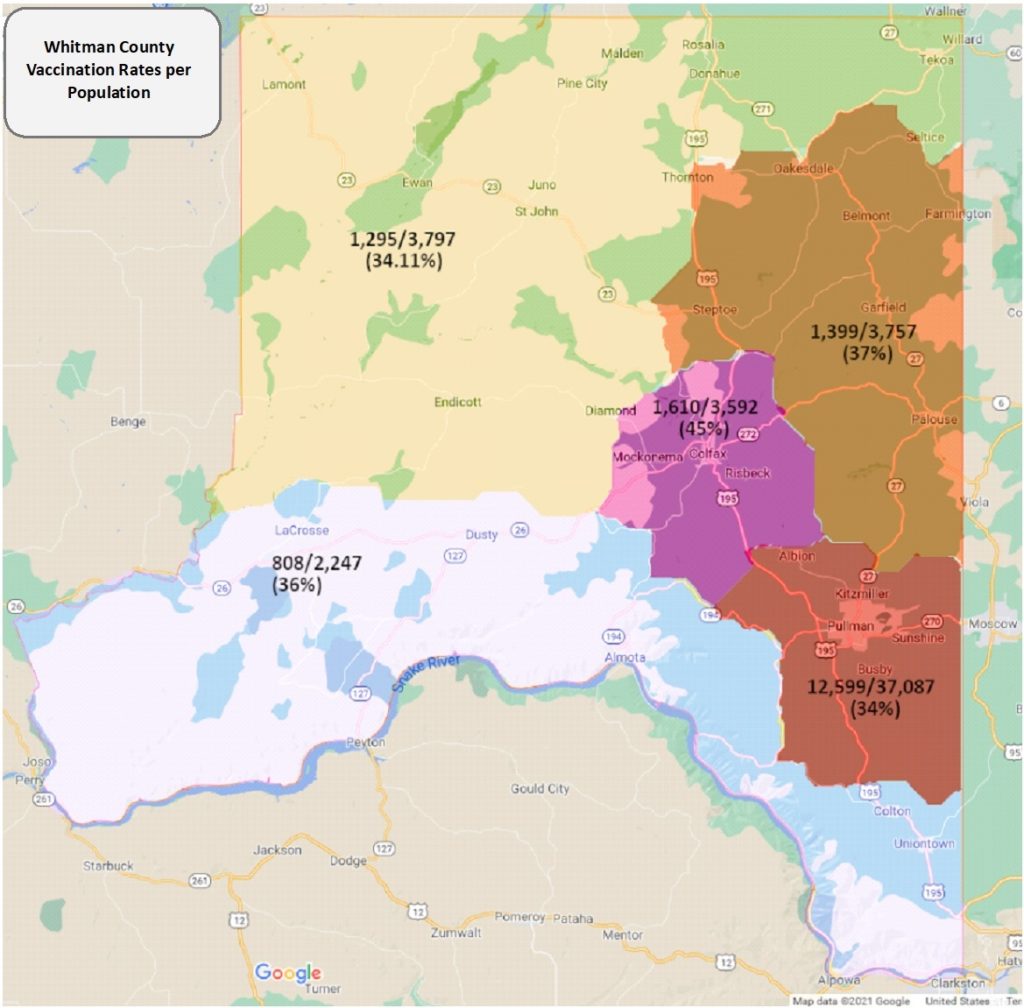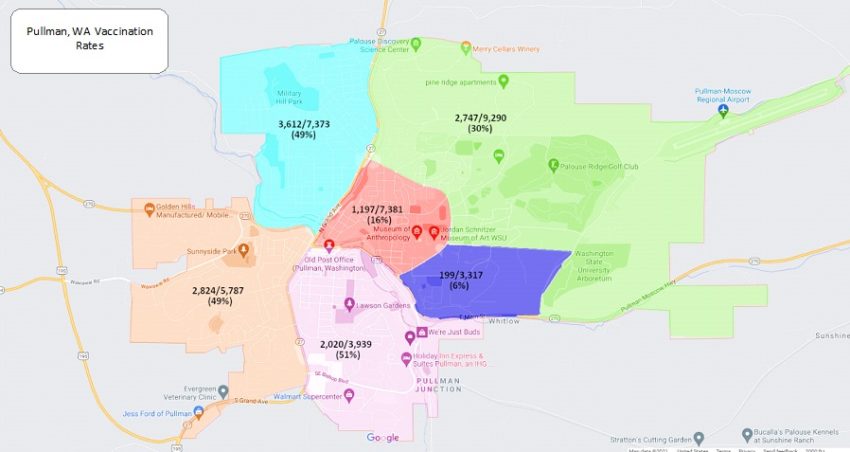As COVID-19 cases rise again statewide, county public health officials reported local declines have leveled off in recent weeks and unvaccinated populations remain vulnerable to the highly transmissible, increasingly dominant Delta strain.
Public Health Director Chris Skidmore told the county Board of Health on Monday that local case rates have stalled at about 48 cases per 100,000 residents over 14 days — just below the “moderate” transmission activity level.
“Our case rates remain low,” he said. “[But] statewide our cases are going up and we have a couple hotspots.”
Skidmore noted Walla Walla and Benton counties had recently seen significant increases in new cases, presumably among pockets of unvaccinated individuals. The latest Whitman County numbers showed most local vaccination rates continued to fall short of the state average.
“We expect to see the hospitalization rates statewide follow the trend of the case rates,” he said. “We’d expect to see our hospitalization rates creep up in a week or two.”
Skidmore on Monday released maps of vaccination rates across the county in part to help explain why local officials believe some areas of Whitman County likely have higher vaccination rates than the state has reported.
State officials recently announced 70 percent of the eligible 16-plus population in Washington had initiated vaccination and about 56 percent of the whole population has gotten at least one shot.
State data indicates Whitman County has just 40 percent of its 16-plus population started with vaccinations and 36 percent of its total population.
Skidmore pulled geographic data from the state immunization system to show the county’s lowest vaccination rates are in areas of Pullman that have high WSU student occupancy. He believes that while the students still count toward the total population, they are either not here to be vaccinated locally or have registered home addresses outside the county.
“That’s kind of what we think is happening,” he said. “For us, it’s a huge deal because they [WSU students] are half of our population.”
The Pullman map (click here to see larger) shows 16 percent vaccination on College Hill, 30 percent in sections of “Apartment Land” and just 6 percent in other areas near campus.
Skidmore said he would expect Pullman to have one of the highest vaccination rates in the county because of greater access to convenient vaccine clinics. He estimated the city’s actual rates were closer to the approximately 50 percent vaccination rates seen in the Pioneer, Sunnyside and Military hill areas.
Early numbers from WSU have suggested a high number of returning students will be vaccinated, Skidmore said. Student applications for fall housing have so far indicated the vast majority would be vaccinated.
“Not very many folks are asking for the exemption,” he said, noting those could increase as the start of school approaches.
The Whitman County Gazette recently reported Pullman saw an estimated 7 percent population decrease this past year. Skidmore said he hoped to discuss those population dynamics with state officials later this week, noting he did not know how the state counts other transient groups such as migrant workers or seasonal seafood workers.

Outside of Pullman, vaccinations in rural areas still lagged behind the state average. The vaccination maps showed a 45 percent vaccine initiation rate for the Colfax area and about 36 percent vaccination for other rural areas of the county. Those rates reflected the total population, including children not yet eligible.
Skidmore said he hopes to conduct vaccine clinics at a number of schools at the start of the school year, offering COVID shots for those 12 and older as well as traditional vaccines like MMR for any other children who might need them.
The CDC recently announced new guidance for operating schools this fall, including continued distancing and masks for unvaccinated individuals only. Skidmore said he expected the state to adopt most of those policies soon.
On Monday, the American Academy of Pediatrics issued a stricter masking recommendation, calling for all students and staff to continue masking amid the rise of the Delta strain.
The Lewiston Tribune also published a story today on vaccination efforts in Whitman County and neighboring areas.
The county’s Environmental Health office — which conducts restaurant, septic and other inspections — also reported a backlog in inspections and permits due to short staffing on Monday.
“I have no staff and a lot of work to do,” Environmental Health Director Chelsea Cannard said. “We’re just powering through. I have high hopes.”
The department is looking to hire two Environmental Health Technicians and an Office Specialist as soon as possible.
Skidmore also noted Public Health had posted a variety of resources online for coping with the poor air quality from regional wildfires. Find our recent post on local wildfire tracking and smoke forecasting tools here.
The next Board of Health meeting is scheduled for 3 p.m. on Sept. 20.
